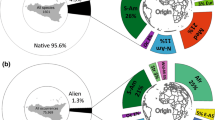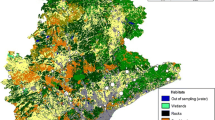Abstract
Invasion by alien species is a growing concern for nature conservation. We estimated the level of invasion by alien plant species and future invasion risks at the European scale. We used a pan-European atlas and eight regional plant atlases to determine the distribution of alien and native plant richness. In addition, we estimated alien and native dark diversity (species currently absent from a site but present in the surrounding region and able to colonize the site). We used relative diversity metrics to indicate current and future risks by alien species: relative alien richness (compared to native species), alien and native completeness (log-ratio of observed to dark diversity) and completeness difference between alien and native species. Observed and relative richness of alien species were greatest in NW Europe; this suggests that sites in NW Europe could be more disturbed. Observed alien and native species richness show clear regional hotspots; the distribution of completeness values is dispersed, indicating local hotspots. Northern Europe has relatively lower alien completeness, likely because potential invaders inhabit the region but have not yet reached many localities, thereby suggesting a risk of future invasion. A greater number of potential alien species in the region increases the probability that some alien species could have detrimental impacts. Both alien richness and completeness are positively correlated with native richness and completeness, respectively, indicating that both groups share similar distribution patterns. Alien species diversity metrics in Europe are related positively to human population density and agricultural land-use. We suggest that the dark diversity concept can broaden our understanding of alien species diversity and future invasion risks.



Similar content being viewed by others
References
Alpert P (2006) The advantages and disadvantages of being introduced. Biol Invasions 8:1523–1534. doi:10.1007/s10530-005-5844-z
Araújo MB (2003) The coincidence of people and biodiversity in Europe. Glob Ecol Biogeogr 12:5–12. doi:10.1046/j.1466-822X.2003.00314.x
Beals EW (1984) Bray–curtis ordination: an effective strategy for analysis of multivariate ecological data. Adv Ecol Res 14:1–55. doi:10.1016/s0065-2504(08)60168-3
Bellard C, Thuiller W, Leroy B, Genovesi P, Bakkenes M, Courchamp F (2013) Will climate change promote future invasions? Glob Change Biol 19:3740–3748. doi:10.1111/gcb.12344
Bossard M, Feranec J, Otahel J (2000) CORINE land cover technical guide: addendum 2000. European Environment Agency, Copenhagen
Brunzel S, Fischer SF, Schneider J, Jetzkowitz J, Brandl R (2009) Neo- and archaeophytes respond more strongly than natives to socio-economic mobility and disturbance patterns along an urban-rural gradient. J Biogeogr 36:835–844. doi:10.1111/j.1365-2699.2008.02044.x
Butchart SHM et al (2010) Global biodiversity: indicators of recent declines. Science 328:1164–1168. doi:10.1126/science.1187512
Carboni M et al (2016) What it takes to invade grassland ecosystems: traits, introduction history and filtering processes. Ecol Lett 19:219–229. doi:10.1111/ele.12556
Carstensen DW, Lessard J-P, Holt BG, Krabbe Borregaard M, Rahbek C (2013) Introducing the biogeographic species pool. Ecography 36:1310–1318. doi:10.1111/j.1600-0587.2013.00329.x
Chytrý M, Pyšek P, Wild J, Pino J, Maskell LC, Vilà M (2009) European map of alien plant invasions based on the quantitative assessment across habitats. Divers Distrib 15:98–107. doi:10.1111/j.1472-4642.2008.00515.x
Chytrý M et al (2012) Projecting trends in plant invasions in Europe under different scenarios of future land-use change. Glob Ecol Biogeogr 21:75–87. doi:10.1111/j.1466-8238.2010.00573.x
Davies KF, Chesson P, Harrison S, Inouye BD, Melbourne BA, Rice KJ (2005) Spatial heterogeneity explains the scale dependence of the native–exotic diversity relationship. Ecology 86:1602–1610. doi:10.1890/04-1196
Davis MA, Pelsor M (2001) Experimental support for a resource-based mechanistic model of invasibility. Ecol Lett 4:421–428. doi:10.1046/j.1461-0248.2001.00246.x
di Castri F (1989) History of biological invasions with special emphasis on the Old World. Biol Invasions 37:1–30
Dormann CF et al (2007) Methods to account for spatial autocorrelation in the analysis of species distributional data: a review. Ecography 30:609–628. doi:10.1111/j.2007.0906-7590.05171.x
Ellis EC, Antill EC, Kreft H (2012) All is not loss: plant biodiversity in the Anthropocene. PLoS One 7:e30535. doi:10.1371/journal.pone.0030535
Ewald J (2002) A probabilistic approach to estimating species pools from large compositional matrices. J Veg Sci 13:191–198. doi:10.1111/j.1654-1103.2002.tb02039.x
Feng J, Zhang Z, Nan R (2011) The roles of climatic factors in spatial patterns of alien invasive plants from America into China. Biodivers Conserv 20:3385–3391. doi:10.1007/s10531-011-0122-0
Fridley JD et al (2007) The invasion paradox: reconciling pattern and process in species invasions. Ecology 88:3–17. doi:10.1890/0012-9658(2007)88[3:tiprpa]2.0.co;2
Goldewijk KK, Beusen A, van Drecht G, de Vos M (2011) The HYDE 3.1 spatially explicit database of human-induced global land-use change over the past 12,000 years. Glob Ecol Biogeogr 20:73–86. doi:10.1111/j.1466-8238.2010.00587.x
Graves GR, Rahbek C (2005) Source pool geometry and the assembly of continental avifaunas. Proc Natl Acad Sci USA 102:7871–7876. doi:10.1073/pnas.0500424102
Hawkins BA et al (2003) Energy, water, and broad-scale geographic patterns of species richness. Ecology 84:3105–3117. doi:10.1890/03-8006
Hijmans RJ, Cameron SE, Parra JL, Jones PG, Jarvis A (2005) Very high resolution interpolated climate surfaces for global land areas. Int J Climatol 25:1965–1978. doi:10.1002/joc.1276
Hulme PE, Nentwig W, Pyšek P, Vilà M (2009) Common market, shared problems: time for a coordinated response to biological invasions in Europe? In: Pysek P, Pergl J (eds) Biological invasions: towards a synthesis. Proceedings of the Neobiota, vol 8 pp 3–19
Jalas J, Suominen J (1972–1994) Atlas Florae Europaeae. Volume 1 (1972), 2 (1973), 3 (1976), 4 (1979), 5 (1980), 6 (1983), 7 (1986), 8 (1989), 9 (1991), 10 (1994). Committee for Mapping the Flora of Europe and Societas Biologica Fennica Vanamo, Helsinki
Jalas J, Suominen J, Lampinen R (1996) Atlas Florae Europaeae, vol 11. Committee for Mapping the Flora of Europe and Societas Biologica Fennica, Helsinki
Jalas J, Suominen J, Lampinen R, Kurtto A (1999) Atlas Florae Europaeae, vol 12. Committee for Mapping the Flora of Europe and Societas Biologica Fennica Vanamo, Helsinki
Jost L (2006) Entropy and diversity. Oikos 113:363–375. doi:10.1111/j.2006.0030-1299.14714.x
Kalusová V, Chytrý M, Peet RK, Wentworth TR (2014) Alien species pool influences the level of habitat invasion in intercontinental exchange of alien plants. Glob Ecol Biogeogr 23:1366–1375. doi:10.1111/geb.12209
Kalwij JM, Robertson MP, Ronk A, Zobel M, Pärtel M (2014) Spatially-explicit estimation of geographical representation in large-scale species distribution datasets. PLoS One 9:e85306. doi:10.1371/journal.pone.0085306
Keil P et al (2012) Patterns of beta diversity in Europe: the role of climate, land cover and distance across scales. J Biogeogr 39:1473–1486. doi:10.1111/j.1365-2699.2012.02701.x
Kowarik I (2011) Novel urban ecosystems, biodiversity, and conservation. Environ Pollut 159:1974–1983. doi:10.1016/j.envpol.2011.02.022
Kurtto A, Lampinen R, Junikka L (2004) Atlas Florae Europaeae. Distribution of vascular plants in Europe. 13. Rosaceae (Spiraea to Fragaria, excl. Rubus). The Committee for Mapping the Flora of Europe & Societas Biologica Fennica Vanamo, Helsinki
La Sorte FA et al (2014) Beta diversity of urban floras among European and non-European cities. Glob Ecol Biogeogr 23:769–779. doi:10.1111/geb.12159
Lambdon PW et al (2008) Alien flora of Europe: species diversity, temporal trends, geographical patterns and research needs. Preslia 80:101–149
Lampinen R, Lahti T (2013) Kasviatlas 2012. Helsingin Yliopisto, Luonnontieteellinen keskusmuseo, Helsinki
Legendre P (2014) lmodel2: Model II regression. R package version 1.7-2, 1.7-2 edn
Lewis RJ et al (2016a) Applying the dark diversity concept to nature conservation. Conserv Biol. doi:10.1111/cobi.12723
Lewis RJ, Szava-Kovats R, Pärtel M (2016b) Estimating dark diversity and species pools: an empirical assessment of two methods. Methods Ecol Evol 7:104–113. doi:10.1111/2041-210x.12443
Lososová Z et al (2012) Native and alien floras in urban habitats: a comparison across 32 cities of central Europe. Glob Ecol Biogeogr 21:545–555. doi:10.1111/j.1466-8238.2011.00704.x
Mittelbach GG et al (2007) Evolution and the latitudinal diversity gradient: speciation, extinction and biogeography. Ecol Lett 10:315–331. doi:10.1111/j.1461-0248.2007.01020.x
Mooney HA, Hobbs RJ (2000) Global change and invasive species: where do we go from here invasive species in a changing world. Island Press, Washington, DC, pp 425–434
Pärtel M, Szava-Kovats R, Zobel M (2011) Dark diversity: shedding light on absent species. Trends Ecol Evol 26:124–128. doi:10.1016/j.tree.2010.12.004
Pärtel M, Szava-Kovats R, Zobel M (2013) Community completeness: linking local and dark diversity within the species pool concept. Folia Geobot 48:307–317. doi:10.1007/s12224-013-9169-x
Pinheiro J, Bates D, DebRoy S, Sarkar D, R Core Team (2015) nlme: linear and nonlinear mixed effects models. R package version 3.1-122
Pyšek P (2003) How reliable are data on alien species in Flora Europaea? Flora 198:499–507
Pyšek P, Sádlo J, Mandák B (2002) Catalogue of alien plants of the Czech Republic. Preslia 74(2):97–186
Pyšek P, Jarošík V, Chytrý M, Kropáč Z, Tichý L, Wild J (2005) Alien plants in temperate weed communities: prehistoric and recent invaders occupy different habitats. Ecology 86:772–785
Pyšek P, Richardson DM, Pergl J, Jarošík V, Sixtova Z, Weber E (2008) Geographical and taxonomic biases in invasion ecology. Trends Ecol Evol 23:237–244. doi:10.1016/j.tree.2008.02.002
R Core Team (2015) R: a language and environment for statistical computing. R Foundation for Statistical Computing, Vienna
Rejmánek M (1996) Species richness and resistance to invasions. In: Orians G, Dirzo R, Cushman JH (eds) Biodiversity and ecosystem processes in tropical forests, vol 122. Ecological Studies. Springer, Berlin, pp 153–172. doi:10.1007/978-3-642-79755-2_8
Rejmánek M (1999) Invasive plant species and invasible ecosystems. In: Sandlund OY (ed) Invasive species and biodiversity management. Kluwer Academic Publisher, Dordrecht, pp 79–102
Ronk A, Szava-Kovats R, Pärtel M (2015) Applying the dark diversity concept to plants at the European scale. Ecography 38:1015–1025. doi:10.1111/ecog.01236
Stohlgren TJ et al (1999) Exotic plant species invade hot spots of native plant diversity. Ecol Monogr 69:25–46. doi:10.1890/0012-9615(1999)069[0025:epsihs]2.0.co;2
Thuiller W, Richardson DM, Pyšek P, Midgley GF, Hughes GO, Rouget M (2005) Niche-based modelling as a tool for predicting the risk of alien plant invasions at a global scale. Glob Change Biol 11:2234–2250. doi:10.1111/j.1365-2486.2005.01018.x
Thuiller W, Richardson DM, Midgley GF (2007) Will climate change promote alien plant invasions? In: Nentwig W (ed) Biological invasions. Springer, Berlin, pp 197–211
Vellend M, Lilley PL, Starzomski BM (2008) Using subsets of species in biodiversity surveys. J Appl Ecol 45:161–169. doi:10.1111/j.1365-2664.2007.01413.x
Walther G-R et al (2009) Alien species in a warmer world: risks and opportunities. Trends Ecol Evol 24:686–693. doi:10.1016/j.tree.2009.06.008
Wania A, Kühn I, Klotz S (2006) Plant richness patterns in agricultural and urban landscapes in Central Germany: spatial gradients of species richness. Landsc Urban Plan 75:97–110. doi:10.1016/j.landurbanplan.2004.12.006
Weber EF (1997) The alien flora of Europe: a taxonomic and biogeographic review. J Veg Sci 8:565–572. doi:10.2307/3237208
Williamson M et al (2009) The distribution of range sizes of native and alien plants in four European countries and the effects of residence time. Divers Distrib 15:158–166. doi:10.1111/j.1472-4642.2008.00528.x
Zobel M (2016) The species pool concept as a framework for studying patterns of plant diversity. J Veg Sci 27:8–18. doi:10.1111/jvs.12333
Acknowledgements
We thank Milan Chytrý for valuable comments. This study was supported by the Estonian Ministry of Education and Research, institutional research funding (IUT 20-28, 20-29) and the European Union through the European Regional Development Fund (Centre of Excellence EcolChange).
Author information
Authors and Affiliations
Corresponding author
Additional information
Communicated by Daniel Sanchez Mata.
This article belongs to the Topical Collection: Invasive species.
Electronic supplementary material
Below is the link to the electronic supplementary material.
Rights and permissions
About this article
Cite this article
Ronk, A., Szava-Kovats, R., Zobel, M. et al. Observed and dark diversity of alien plant species in Europe: estimating future invasion risk. Biodivers Conserv 26, 899–916 (2017). https://doi.org/10.1007/s10531-016-1278-4
Received:
Revised:
Accepted:
Published:
Issue Date:
DOI: https://doi.org/10.1007/s10531-016-1278-4




